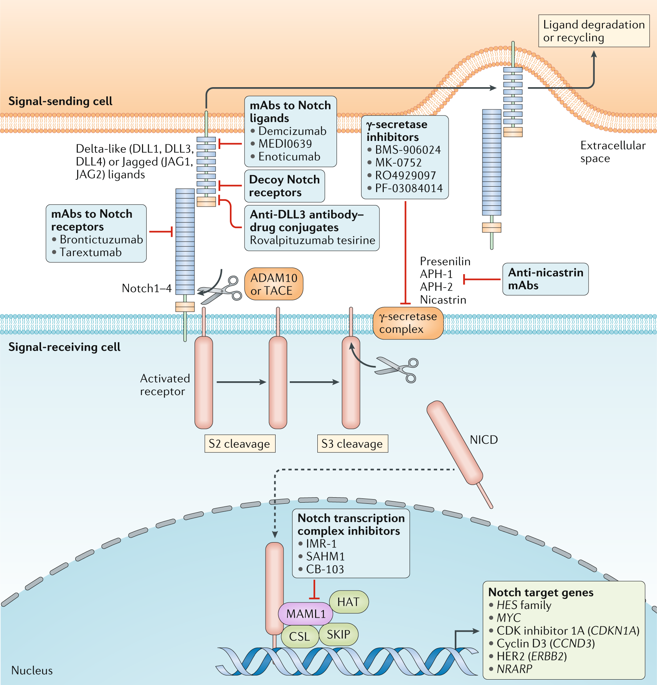当前位置:
X-MOL 学术
›
Nat. Rev. Clin. Oncol.
›
论文详情
Our official English website, www.x-mol.net, welcomes your feedback! (Note: you will need to create a separate account there.)
Targeting signalling pathways and the immune microenvironment of cancer stem cells - a clinical update.
Nature Reviews Clinical Oncology ( IF 78.8 ) Pub Date : 2019-12-02 , DOI: 10.1038/s41571-019-0293-2 Joseph A Clara 1 , Cecilia Monge 2 , Yingzi Yang 3 , Naoko Takebe 2
Nature Reviews Clinical Oncology ( IF 78.8 ) Pub Date : 2019-12-02 , DOI: 10.1038/s41571-019-0293-2 Joseph A Clara 1 , Cecilia Monge 2 , Yingzi Yang 3 , Naoko Takebe 2
Affiliation

|
Cancer stem cells (CSCs) have important roles in tumour development, relapse and metastasis; the intrinsic self-renewal characteristics and tumorigenic properties of these cells provide them with unique capabilities to resist diverse forms of anticancer therapy, seed recurrent tumours, and disseminate to and colonize distant tissues. The findings of several studies indicate that CSCs originate from non-malignant stem or progenitor cells. Accordingly, inhibition of developmental signalling pathways that are crucial for stem and progenitor cell homeostasis and function, such as the Notch, WNT, Hedgehog and Hippo signalling cascades, continues to be pursued across multiple cancer types as a strategy for targeting the CSCs hypothesized to drive cancer progression - with some success in certain malignancies. In addition, with the renaissance of anticancer immunotherapy, a better understanding of the interplay between CSCs and the tumour immune microenvironment might be the key to unlocking a new era of oncological treatments associated with a reduced propensity for the development of resistance and with enhanced antimetastatic activity, thus ultimately resulting in improved patient outcomes. Herein, we provide an update on the progress to date in the clinical development of therapeutics targeting the Notch, WNT, Hedgehog and Hippo pathways. We also discuss the interactions between CSCs and the immune system, including the potential immunological effects of agents targeting CSC-associated developmental signalling pathways, and provide an overview of the emerging approaches to CSC-targeted immunotherapy.
中文翻译:

靶向信号通路和癌症干细胞的免疫微环境-临床更新。
癌症干细胞(CSC)在肿瘤发展,复发和转移中具有重要作用;这些细胞固有的自我更新特征和致瘤特性为它们提供了独特的能力,可以抵抗多种形式的抗癌治疗,种子复发性肿瘤以及向远处的组织扩散和定居。几项研究的结果表明,CSC起源于非恶性干细胞或祖细胞。因此,抑制多种对于干细胞和祖细胞稳态和功能至关重要的发育信号通路,例如Notch,WNT,Hedgehog和Hippo信号级联,一直是针对多种癌症类型的研究,以此作为靶向假定驱动的CSC的策略。癌症进展-在某些恶性肿瘤中取得了一些成功。此外,随着抗癌免疫疗法的复兴,更好地了解CSC与肿瘤免疫微环境之间的相互作用可能是开启新的肿瘤治疗时代的关键,该时代将降低耐药性的发展趋势并增强抗转移活性,从而最终从而改善了患者的预后。在此,我们提供了针对Notch,WNT,Hedgehog和Hippo途径的疗法的临床开发进展的最新进展。我们还讨论了CSC与免疫系统之间的相互作用,包括针对CSC相关的发育信号通路的药物的潜在免疫学作用,并概述了针对CSC的免疫疗法的新兴方法。更好地了解CSC与肿瘤免疫微环境之间的相互作用可能是开启新的肿瘤治疗时代的关键,这种时代与耐药性的降低倾向和抗转移活性相关,从而最终改善了患者的预后。在此,我们提供了针对Notch,WNT,Hedgehog和Hippo途径的疗法的临床开发进展的最新进展。我们还讨论了CSC与免疫系统之间的相互作用,包括针对CSC相关的发育信号通路的药物的潜在免疫学作用,并概述了针对CSC的免疫疗法的新兴方法。更好地了解CSC与肿瘤免疫微环境之间的相互作用可能是开启新的肿瘤治疗时代的关键,这种时代与耐药性的降低倾向和抗转移活性相关,从而最终改善了患者的预后。在此,我们提供了针对Notch,WNT,Hedgehog和Hippo途径的疗法的临床开发进展的最新进展。我们还讨论了CSC与免疫系统之间的相互作用,包括针对CSC相关的发育信号通路的药物的潜在免疫学作用,并概述了针对CSC的免疫疗法的新兴方法。
更新日期:2019-12-03
中文翻译:

靶向信号通路和癌症干细胞的免疫微环境-临床更新。
癌症干细胞(CSC)在肿瘤发展,复发和转移中具有重要作用;这些细胞固有的自我更新特征和致瘤特性为它们提供了独特的能力,可以抵抗多种形式的抗癌治疗,种子复发性肿瘤以及向远处的组织扩散和定居。几项研究的结果表明,CSC起源于非恶性干细胞或祖细胞。因此,抑制多种对于干细胞和祖细胞稳态和功能至关重要的发育信号通路,例如Notch,WNT,Hedgehog和Hippo信号级联,一直是针对多种癌症类型的研究,以此作为靶向假定驱动的CSC的策略。癌症进展-在某些恶性肿瘤中取得了一些成功。此外,随着抗癌免疫疗法的复兴,更好地了解CSC与肿瘤免疫微环境之间的相互作用可能是开启新的肿瘤治疗时代的关键,该时代将降低耐药性的发展趋势并增强抗转移活性,从而最终从而改善了患者的预后。在此,我们提供了针对Notch,WNT,Hedgehog和Hippo途径的疗法的临床开发进展的最新进展。我们还讨论了CSC与免疫系统之间的相互作用,包括针对CSC相关的发育信号通路的药物的潜在免疫学作用,并概述了针对CSC的免疫疗法的新兴方法。更好地了解CSC与肿瘤免疫微环境之间的相互作用可能是开启新的肿瘤治疗时代的关键,这种时代与耐药性的降低倾向和抗转移活性相关,从而最终改善了患者的预后。在此,我们提供了针对Notch,WNT,Hedgehog和Hippo途径的疗法的临床开发进展的最新进展。我们还讨论了CSC与免疫系统之间的相互作用,包括针对CSC相关的发育信号通路的药物的潜在免疫学作用,并概述了针对CSC的免疫疗法的新兴方法。更好地了解CSC与肿瘤免疫微环境之间的相互作用可能是开启新的肿瘤治疗时代的关键,这种时代与耐药性的降低倾向和抗转移活性相关,从而最终改善了患者的预后。在此,我们提供了针对Notch,WNT,Hedgehog和Hippo途径的疗法的临床开发进展的最新进展。我们还讨论了CSC与免疫系统之间的相互作用,包括针对CSC相关的发育信号通路的药物的潜在免疫学作用,并概述了针对CSC的免疫疗法的新兴方法。



























 京公网安备 11010802027423号
京公网安备 11010802027423号